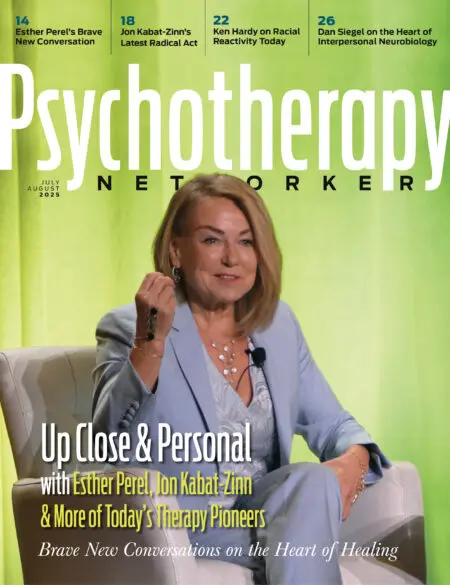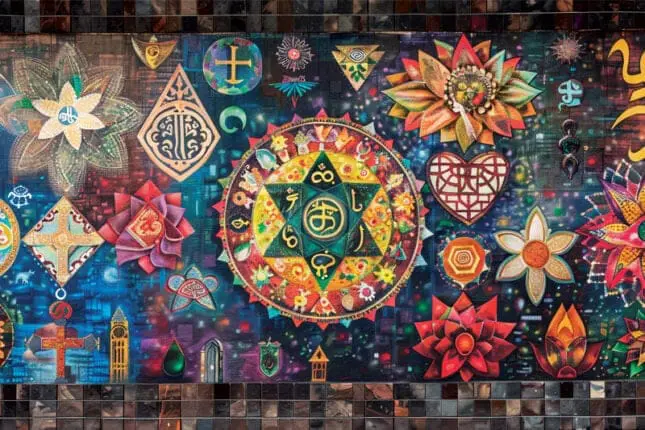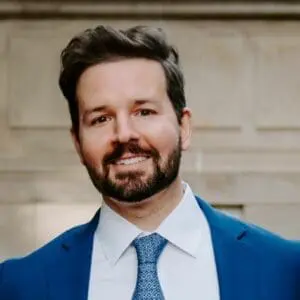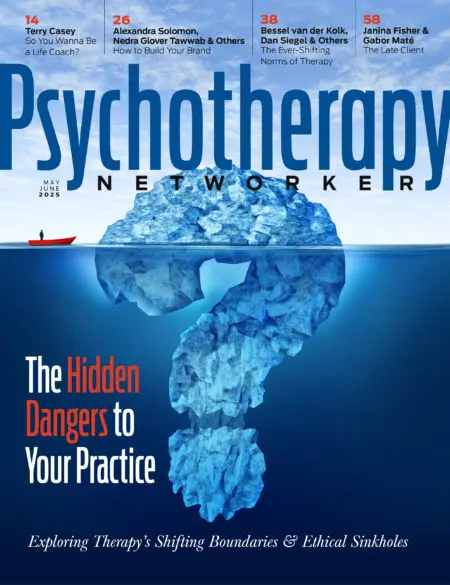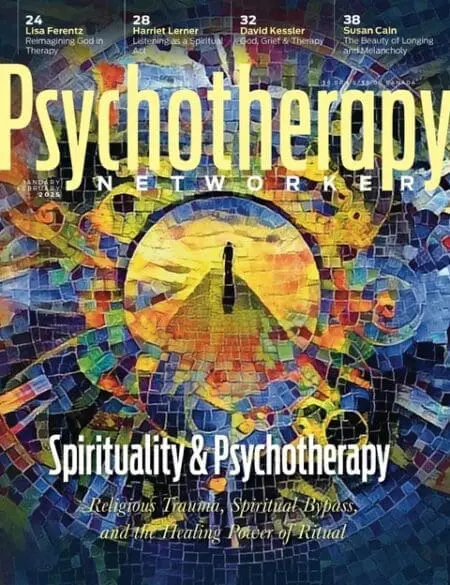When you think of the word pilgrimage, what comes to mind? Is it a robe-clad wayfarer, trudging tirelessly across some far-off desert? A weary knight, dismounting from his horse after a long, perilous journey to kneel at some shining altar? Or perhaps a pious devotee, pressing her forehead against the warm clay of a wailing wall?
Whatever you imagine, chances are you’re not picturing someone slipping on a sweatshirt and joggers, pushing through a crowded Manhattan subway turnstile, taking the red line downtown, and walking three blocks to a therapist’s office on the outskirts of New York’s Financial District. Lawrence of Arabia this is not. But a pilgrimage? Absolutely. Just ask anyone who’s passed through the doors of the Psychotherapy and Spirituality Institute. For many, what happens there is more than just good therapy: it’s a sacred homecoming.
For Sarah McCaslin, an ordained minister, licensed clinician, and the executive director of PSI, that’s exactly the point. In her practice, the therapist’s office isn’t just a place to talk about your day-to-day troubles, but a place to explore more amorphous concepts, including your faith, your sense of spirituality, or that feeling of smallness you get when you look up at a big black sky full of stars. You might ask questions like How can I manage my anxiety? or How can I communicate better with my partner? But you might ask others, like Who am I? or Where do I belong? or Is there a higher power, and if so, do they accept me as I am?
It’s tempting to believe that PSI’s offices, which once served as living quarters for nuns, still hold some sort of lingering mystical energy that its new clinical inhabitants can call upon. After all, clients seek out PSI because they want a therapist who can examine their problems with a spiritual lens. Many have experienced spiritual trauma, like being rejected by a religious family or community, but still derive some benefit from religion they don’t want to abandon entirely. And many haven’t felt comfortable bringing up their complex feelings about religion and spirituality with other therapists.
So what makes PSI any different? “Spiritual and religious fluency,” McCaslin says. Like her, many of its therapists have two identities. “I’m a clinician,” she explains, “but I’m also clergy. Whenever I walk into a room, that’s also who I am.”
Oil and Water?
You might be inclined to think of spiritually informed therapy as a more modern form of pastoral counseling. But that’s a mischaracterization, McCaslin says. “Pastoral counseling used to be all the rage in the 60s and 70s,” she explains, “a way to give pastoral leaders the provisions to offer mental health care to congregants. But that term and model have gone out of fashion. Today, religious and nonreligious people alike trust therapists with their mental health.”
True as this might be, it begs a question: do religion and spirituality really belong in therapy? If the idea of wading into the nonsecular evokes a visceral nope from you, you’re not alone. In its original conception, psychotherapy was decidedly nonreligious. When Sigmund Freud and B.F. Skinner developed psychoanalysis and behaviorism in the late 19th and early 20th centuries, the intention was to establish psychology as a hard science. Any inclusion of religion was considered aberrant and regressive—“patently infantile” and “foreign to reality,” Freud wrote in his 1930 Civilization and Its Discontents.
Vestiges of these attitudes still exist today. According to a 2013 examination of therapists’ attitudes toward religion published in the APA Handbook of Psychology, Religion, and Spirituality, most psychologists are nonreligious. Some are even spiritually averse, often due to their own negative experiences with religion or because they see a moral or ethical need to avoid religious discussions in therapy. Less than a third of clinicians say they’ve discussed religion or spirituality with clients, and less than half say they mention it during assessment or treatment planning.
But how much potential exploration and healing is missed when therapists ignore these conversations? Not only do 70 percent of U.S. adults say religion is important in their lives, according to a 2023 Gallup poll, but most clients want the opportunity to discuss religion or spirituality with their therapist, according to a 2020 study in the journal Religions. In addition, a considerable body of research indicates that spiritual and religious beliefs are relevant to mental health, and that spiritual practices like prayer are correlated with lower levels of depression, anxiety, suicidal ideation and attempts, PTSD, and substance abuse, as well as higher levels of hope, optimism, and self-esteem.
Decades after Freud, it seems the field has slowly come around to the idea that religion and spirituality have a place in psychotherapy. The APA’s Ethics Code states that therapists should be “aware of and respect cultural, individual, and role differences, including those based on religion, and consider these factors when working with members of such groups.” Yet while 89 percent of therapists today agree that clinicians should receive training on religion or spirituality as it relates to mental health, according to a 2023 article in the journal BMC Psychology, most report receiving little to no training at all. As a result, they feel unqualified to discuss it, or worry that doing so would be unethical.
McCaslin is quick to note that what she and her team practice is ethical psychotherapy—not religious counseling, proselytizing, or evangelizing. “Some people might feel wary when god comes up in therapy,” she says. “But if we can talk about things like drugs, sex, and money, then why not God? As psychotherapists, our job is to help clients create meaning when life gets complicated. Our job is to listen well and help them tap into resources they can lean on, including their experience of what they might call transcendence or the divine.”
Identity, Belonging, and Self-Acceptance
No, therapists don’t conduct baptisms, preside over your child’s bar mitzvah, or officiate at weddings or funerals. But when it comes to that quality of shepherding—providing comfort, validation, community, and guidance in times of need—is there really all that much separating clinicians and clergy?
“I think in many ways the therapist has taken on a sort of secular priesthood,” says PSI clinician Lana Hurst. “Even though we’re becoming an increasingly secular society, people are still looking for healers and spaces to work through painful things.”
Hurst, a former pastor, says she comes from “a conservative, high-control Christian tradition,” which she began to break from around the time of her gender transition. After doing pastoral work for more progressive Chrisitan churches and finding herself increasingly attuned to how people were making meaning out of their lives, especially after painful experiences in religious spaces, she decided to enroll in a mental health counseling program. In 2022, after graduating, she began interning at PSI.
“I felt like I could combine two worlds without having to leave one behind,” Hurst notes of the career change. “Even though I came from a Christianity that says psychotherapy is demonic, that it leads people away from god, my experience has been quite the opposite. I’m not leading my clients to a Christian god, of course, but to the divinity within themselves.”
Hurst says around three-quarters of her clients are transgender or gender-nonconforming, and that many have experienced spiritual trauma. “They’re coming in with all sorts of questions,” she says. “They’re wondering what it means to embody their gender and what it means for their relationships. They’re wondering what it means for their survival in a world that tells them they don’t get to exist in this way.”
Hurst also sees cisgender clients, who find themselves wrestling with a religion that no longer serves them. “I see a lot of purity culture trauma,’” she explains. “These clients are struggling with parts of themselves, particularly around sexuality, that haven’t had any expression or acknowledgment.”
Does that word parts sounds familiar? Hurst says one of her favorite and most effective interventions for spiritual trauma is Internal Family Systems, which she says helps clients slow down, notice their wounded and protector parts, and offer compassion to all of them without trying to change them. Then, Hurst asks her clients a question: What if?
“What if you didn’t have to be so protective in this way? What if living this way wasn’t as dangerous as you think it is?” Her job, she explains, “is to help clients find a sense of harmony between those parts of themselves, to empower them to begin to imagine other possibilities.” At the end of the day, she adds, “I want them to leave therapy with a deeper sense that they’re sacred in and of themselves.”
Listening a Little Closer
What makes a therapist spiritually informed? Is it having a spiritual or religious background? Is it some innate personal quality? Or is it something that can be learned by any therapist and honed over time? Maybe, as PSI clinician Shivam Gosai claims, the key is just being a good listener.
It might seem like a no-brainer that listening well is an essential component in any effective therapy. But Gosai says it’s a certain kind of listening—which comes from developing your “Spidey Sense,” as he calls it—that takes therapy from ordinary to spiritually informed.
“Most people don’t come to therapy with spiritual questions,” he says, “but they will come up at some point. I’m very intentional about listening for spiritual elements when clients are talking.”
In 2014, Gosai spent three years living in an ashram in South India, where he studied Advaita Vedanta, a non-dual Hindu school of philosophy that believes the Self and divine consciousness are one in the same. He says the experience, which amounted to a monastic lifestyle that “opened me up to spiritual language and worlds,” helped him hone his curiosity and listening skills. After returning to the U.S., keen on studying psychotherapy with a spiritual perspective, he enrolled in a master’s program, but was surprised and disappointed to find there was virtually no mention of how to work with clients around religion and spirituality.
“I’d assumed that if we were serious about getting to know the whole person, that we’d also learn how to bring in the religious and spiritual side of people,” he says. “But we didn’t. There was just one day in class where we talked about it, and that was it.” After graduating, Gosai began looking for spiritual therapy training programs but came up empty-handed—until he found PSI. He was immediately sold, and two years ago, he joined the practice.
Gosai says some of his clients choose to work with him because of his Indian and Hindu background, like the Indian client who told him she talks to Krishna and that he talks back—something she’d never felt comfortable mentioning to other therapists. But he says that most of his clients are young adults in the throes of a “quarter-life crisis,” facing seemingly ordinary challenges with work, relationships, and family. This, Gosai says, is where his Spidey Sense usually starts tingling.
“They’re confronting existential questions about what’s next in their lives,” he says. “This feeling of I’m not happy and I want to change—that’s about identity, which has a spiritual element.” Sometimes he’ll hear something more subtle from a client, like the fact that they’re not sleeping well. “I’ll get curious about their dreams when they do manage to fall asleep, which also brings in a spiritual element,” he says. “Since I take a Jungian perspective, I might use the symbolism of their dreams to get a bigger picture of what’s happening in their life, as well as a sense of the bigger universal narrative flowing through them.”
Gosai acknowledges that wading into this territory might feel strange for most therapists. But you don’t need to spend three years in an ashram to develop your own spiritual muscles. You just need to keep an open mind, he says.
“I’m not my clients’ spiritual teacher or pastor,” Gosai explains. “But I do see the spiritual elements in psychotherapy. I see my clients’ spirituality, make space for it, and apply it toward their goals, which is something they tell me their previous therapists couldn’t or wouldn’t do.”
Spirituality Meets Social Justice
Even if you accept that religion and spirituality have a place in therapy, it’s easy enough to write them off as largely irrelevant to today’s progressive young clients, who are increasingly focused on social justice issues and cultural trauma. But according to PSI clinician Helen Park, who specializes in what she calls “anti-oppressive therapy,” religion and spirituality complement their concerns about systemic racism and oppression—and counterbalance the harm that’s come from psychotherapy’s white, Western colonial background.
Park is one of the newest members of PSI, having joined last May after stints as an artist and art educator working with young trauma survivors. “I wanted to respond to their trauma but couldn’t,” Park says, which compelled her to become a therapist. A practicing Buddhist, she took a Dharma class that happened to be taught by therapists, which solidified her conviction that spirituality had a place in the therapy room. “I loved the depth they brought to the work,” she says. After meeting McCaslin at a training program, she signed on with PSI.
Most of Park’s clients are people of color and immigrants struggling with trauma, often around family of origin experiences, immigration histories, emotional abuse, and domestic violence—problems she says are compounded when systemic racism and oppression impedes their access to inner resources.
Park calls her intervention a “psychospiritual” one: first, she simply holds space for her clients. It’s important to validate their experience when so many do not, she says. Then, she helps them develop a coherent narrative of what’s happening in their lives, often by asking them to tap into their bodies to reclaim their ancestral wisdom. “It doesn’t have to make sense in a cognitive way,” she says, “but it might make sense in your mind and body.”
Park says this kind of spiritual intervention is a breath of fresh air for her clients, who often prefer less Western styles of talk therapy. “They want to talk to someone who takes a more decolonized approach to treatment,” she explains. “Someone who says, ‘Let’s talk about your ancestral or indigenous wisdom.’ To me, that’s very spiritual. And even though spirituality has become marginalized in Western culture, it’s actually a very human experience to long for some understanding of our place in the world.”
At the end of the day, Park adds, all good therapy has a spiritual thread running through it. It’s what attracted her to the profession in the first place. “I never saw therapy as separate from spirituality,” she says. “Being in a room with multiple people every day who are sharing their deepest vulnerabilities and woundings? Walking alongside them and helping them access the wisdom inside them? That’s a deeply spiritual process.”
A Spiritual Homecoming
Every week, PSI’s therapists gather together for a morning meeting, during which they take turns leading the group in a spiritual practice of their choosing, whether a song, a poem, a meditation, or something else. Recently, one of the therapists invited her colleagues to lay down on the nearest soft surface for a breathwork session. Another time, one of the therapists played an Indigo Girls song on his ukelele.
For PSI’s therapists, what they’re doing isn’t just work—“it’s our calling,” as McCaslin likes to say. And it’s gatherings like these that not only sharpen their clinical skills, helping them attune to whatever spiritual glimmers might appear in that day’s sessions, but provide a sense of community, safety, and belonging that, in an increasingly disconnected world, has become something of a rarity.
For McCaslin, Hurst, Gosai, and Park—who’ve traveled their own circuitous, sometimes painful personal, spiritual, and professional journeys, these meetings are also a chance to receive what they offer clients every day: a spiritual refuge.
“I found this work at a time when I was questioning what I was doing in my life,” Park says. “I found my way to it through my own healing, which is still ongoing.”
“We all come from such different modalities, and I love coming together, seeing the different ways we conceptualize things,” Hurst adds. “As a trans person, I usually feel a lot of hesitancy going into spiritually oriented spaces, because I don’t always know what that means for queerness or transness. But at PSI, I feel welcomed.”
“It felt great to come to a place that was so intentional about helping clients access their spiritual parts,” Gosai says, “but also to be in company where I could be really nerdy about the spiritual elements of psychology. Landing here felt like home.”
To all therapists searching for their own sense of home, whether personally or professionally, McCaslin offers an invitation: consider how, in many ways, every good therapist already practices some kind of spiritually informed therapy. After all, at its core, spirituality is an expression of care and connection.
What would it look like if more therapists gave themselves permission to find a spiritual foothold in their own lives, to think outside the clinical box, to ask questions they might not normally ask, and to be a little braver when it comes to topics that may feel unfamiliar? What would it look like if more therapists practiced what they preach?
“We often ask our clients to think bigger, to think broader,” McCaslin says. “Why shouldn’t we do the same?”
Chris Lyford
Chris Lyford is the Senior Editor at Psychotherapy Networker. Previously, he was assistant director and editor of the The Atlantic Post, where he wrote and edited news pieces on the Middle East and Africa. He also formerly worked at The Washington Post, where he wrote local feature pieces for the Metro, Sports, and Style sections. Contact: clyford@psychnetworker.org.
